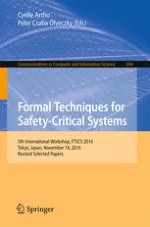2017 | Buch
Formal Techniques for Safety-Critical Systems
5th International Workshop, FTSCS 2016, Tokyo, Japan, November 14, 2016, Revised Selected Papers
herausgegeben von: Cyrille Artho, Peter Csaba Ölveczky
Verlag: Springer International Publishing
Buchreihe : Communications in Computer and Information Science
